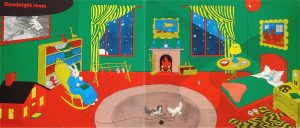In class today, we talked about the characteristics that make Peter Rabbit a good bedtime story. The language used in the story is rhythmic and was written in a way that children could be lulled to sleep very easily. The use of watercolor makes the images soothing to look at, instead of jarring vibrant colors that would excite children and keep them awake longer. Potter’s use of well-timed pauses also adds to the calming effect felt when reading the story. This discussion made me think of another well-known children’s bedtime story, Goodnight Moon and the differences in illustration between the two.
In contrast to the soothing watercolors found in Peter Rabbit, Goodnight Moon uses more bold reds, greens, and yellows. The color palette in Goodnight Moon is much more vibrant, yet it was chosen to illustrate a book with the intention of putting children to sleep. This story has less text than Peter Rabbit, so it is possible that instead of relying on soothing colors to put children to sleep, Goodnight Moon relies more on mentally preparing children to go to sleep. All of the images in Goodnight Moon focus on night time activities, such as getting ready for bed, and perhaps this is what makes the story so effective.
Do you think that one story is more effective as a bedtime story than the other?


Hi Becca,
I hadn’t even thought of goodnight moon, but you’re right–it’s another great example of another children’s book that foregrounded the character of a bunny. I think Goodnight Moon does focus a lot more on just getting the child in the mindset of going to bed. The child literally gets to see the bunny being all tucked up into bed, saying goodnight to everything, despite the vibrant colors which may or may not excite them. It brings to mind the book “Runaway Bunny” which was my favorite bedtime story growing up.
I think bedtime stories are very personal things and have a lot of context to them. It depends on how it is read out loud, the emotions associated with it, a lot is conditional on the reader and in this way gives the parent or whoever is reading it out loud a lot of room for interpretation.
–Erica
Becca,
I love this comparison with Goodnight Moon! Like you said, Beatrix Potter’s use of color as well as her deliberate pauses throughout contribute to the lullaby-like effect of Peter Rabbit. For me, the color palette and the general softness of the illustrations are the driving qualities that make Peter Rabbit a bedtime story. In contrast, I think Goodnight Moon works well as a bedtime story because of its singsong cadence, rather than its loud visuals. Even more so than Peter Rabbit, the language of Goodnight Moon, particularly through repetition, creates a cadence that draws children towards sleep with their parent’s voice alone. Another thing that I love about Goodnight Moon is that you can carry its structure so easily beyond the parameters of the story. My mom used to read Goodnight Moon to my brothers and I when we were little, but soon after, every night, she started doing “Goodnight Mr. Streetlight.” She would run through objects in our house and in our neighborhood, and my brothers and I would add a few of our own, bidding goodnight to each of them. Using the model from the book, we created our own personal lullaby routine. Ultimately I think the real key to Goodnight Moon being a great bedtime story is in the repetition….it’s like counting sheep to fall asleep!